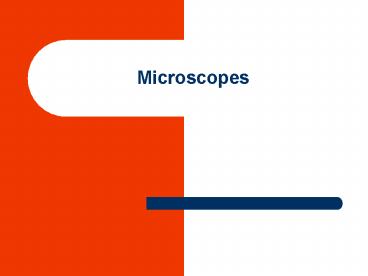Microscopes - PowerPoint PPT Presentation
Title:
Microscopes
Description:
Arial MS P Comic Sans MS Wingdings Times New Roman Capsules 1_Capsules 2_Capsules 3_Capsules 4_Capsules 5_Capsules 6_Capsules 7_Capsules 8 _Capsules 9 ... – PowerPoint PPT presentation
Number of Views:48
Avg rating:3.0/5.0
Title: Microscopes
1
Microscopes
2
History of the microscope
- The first compound microscope was created in the
1590s. - Anthony van Leeuwenhoek and Robert Hooke made
improvements by working on the lenses
3
Robert Hooke
- Discovered the cell
- Hooke coined the term cell for describing
biological organisms. - He examined very thin slices of cork and saw a
multitude of tiny pores that he remarked looked
like the walled compartments of a honeycomb.
4
The compound light microscope
- Has two sets of lenses and allows light to pass
through a specimen to form an image. - It can produce clear images of objects at a
magnification of 1000 times. - Must have two characteristic to be useful
- Magnification
- Resolution
5
Magnification
- Magnification is the enlarging of the image so it
can be seen easier
6
Field of view
Middle power
- The area you see through the microscope.
- The field of view gets smaller as you go from
scanning power to high power. This is why you
find the image under the lowest power first. - Always center the object before you change to a
higher power.
High Power
Lowest power (scanning lens)
7
(No Transcript)
8
Resolution
good resolution
poor resolution
- Resolution is the ability to distinguish between
two points. Clear images are easier to see than
blurry images.
9
Resolution
10
Parts of a microscope
11
Parts functions
- Optical parts of the compound light microscope
- 1. Ocular lens/eye piece
- Contains a magnifying lens, usually 10x or 15x.
To look through.
12
Parts functions
- 2. Objective lens has three different
magnifying lenses. - On our microscopes
- A. Scanning lens magnifies image 4X
- B. Low power magnifies 10X
- C. High power magnifies 40X
13
Total magnification
- How is total magnification of the microscope
determine? - Multiply the magnification of the eye piece lens
by the magnification of the objective lens. - For example if the eye piece is 10X and you use
the low power objective lens which is also 10X,
your total magnification is 100X.
14
Parts functions
- 3. light source
- 4. diaphragm regulates amount of light that
passes up towards the eye piece. - 5. Base support microscope
- 6. Arm supports body tube
- 7. Stage supports slide to be observed.
15
Parts functions
- 8. Body tube keeps proper distance between eye
piece and objectives. - 9. Nosepiece hold objectives, can be rotated.
- 10. Course Adjustment moves body tube in order
to focus the image. - 11. Fine Adjustment moves body tube slightly to
sharpen image.
16
Bacteria
17
Blood cells
18
(No Transcript)
19
How to make a wet-mount slide
- 1. Get a clean slide and cover slip
- 2. Place one drop of water in the middle of the
slide. - 3. Place the edge of the cover slip on one side
of the water drop. - 4. Slowly lower to cover slip on top of the drop
- 5. Place the slide on the stage and first view
with the scanning lens.
20
(No Transcript)































